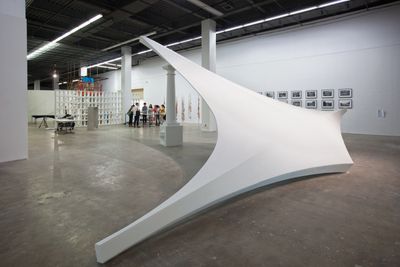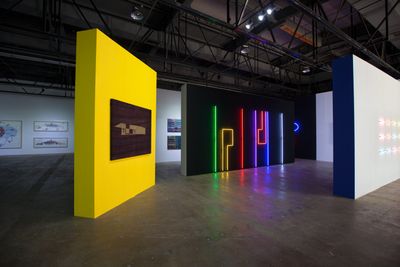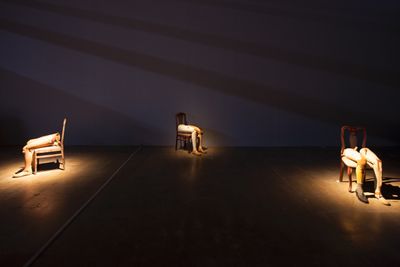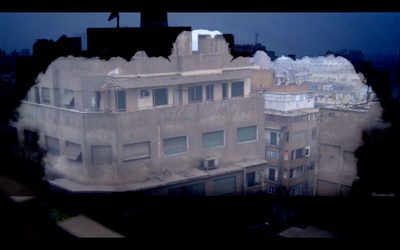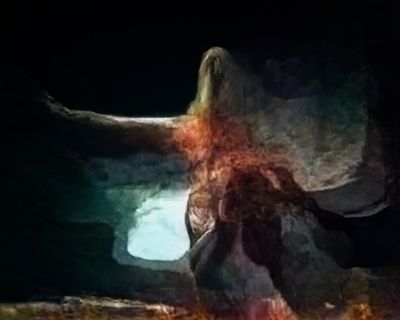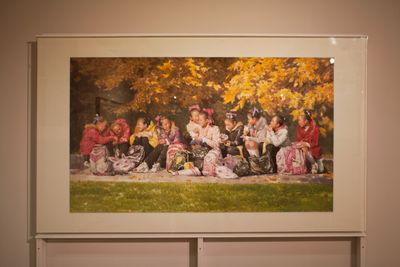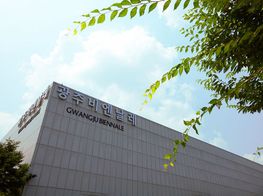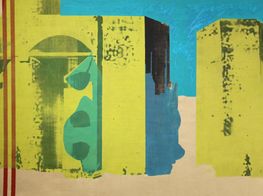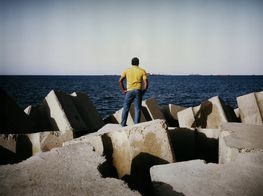Gwangju Biennale: Imagined Borders
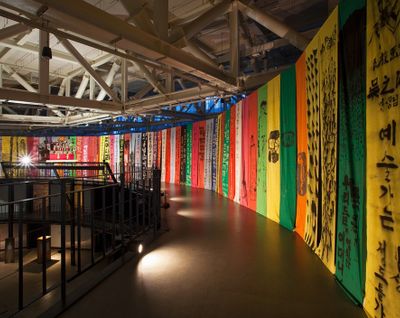
Yeongyun Kang, Between sky and land 4 (1995). Manjang, bier, mixed media installation. Exhibition view: 12th Gwangju Biennale: I_magined Borders_, Asia Culture Center, Gwangju (7 September–11 November 2018). Courtesy Gwangju Biennale Foundation.
'I have felt persecuted for weeks by this same asphyxiating dream.' So narrates the forlorn Portuguese speaker in Kiluanji Kia Henda's film, Concrete Affection – Zopo Lady (2014), as city scenes and modernist buildings in Luanda flit past the camera's lens. The narration is pulled from Another Day of Life (1971), Polish writer Ryszard Kapuscinski's account of the civil strife in the Angolan capital following the 1975 collapse of the Portuguese dictatorship.
Kia Henda's film perfectly encapsulates the sentiment that runs through Modern Utopias, the first of seven sections that make up the 12th Gwangju Biennale, Imagined Borders (7 September–11 November 2018). Here, Clara Kim—one of 11 of the Biennale's curators—brings 26 artists, photographers and filmmakers together to challenge the modernist grand narratives, hinged on a post-World War II internationalist ethos, that sprouted across the world between the 1950s and 70s.
Kim's section opens on the first floor of the Gwangju Biennale Exhibition Hall, a building constructed in 1995, 15 years after the city's May 18 Democratic Uprising, when an assembly of pro-democracy demonstrators was brutally repressed by hard-line military rule. The Biennale was founded at the first pulse of the nation's push into newly founded democratic citizenhood and pursuit of globalisation as a means of eliminating protectionism to open the country's sociopolitical and economic activities.1
To that end, the Exhibition Hall provides a fitting frame for Kim's focus on modernist—and international—aspirations. Lais Myrrha's Estudo de Caso (2018) installation is comprised of a white 1:1 scale plaster model of a kite-shaped column from the Palacio de Alvorada, the official residence of the president of the Brazilian Republic. Leaning vertically, one narrow end of this column rests on another 1:1 scale model of a column from Colubande Farm, a landmark of colonialist architecture. The coming together of the two architectural forms alludes to Brazilian modernism as being awash with the violence of the country's colonial past.
The positioning of Myrhha's monumental structure directs viewers into a room filled with layered installations, including Yto Barrada's Agadir (2018), whose title refers to the eponymous 1967 play by Moroccan writer Mohammad Khair-Eddine, in which a king, a psychic, a cook, and other characters debate how the city might be rebuilt after the devastating earthquake that hit the city in 1960, killing between 12 and 15 thousand people. In a crescent-shaped room, which mimics the shape of the bay of Agadir, viewers encounter the video—composed of spliced and edited news footage of the earthquake's aftermath—projected onto a wall, while illustrations of defining elements of post-earthquake Berber Brutilist architecture are marked in white on the wall opposite.
Modern Utopias sways between the weight of failed modernist projects and the inherent optimism that defined them, as seen in Shezad Dawood's exploration of modernism's spiritual investment. A collection of fluorescent light sculptures hum with colour—their rigid architectural qualities softened by a selection of tapestries jiving with colours and forms. Along with a series of tapestries, these works form part of Dawood's research into modernist architecture of the Indian subcontinent, and how myth, ritual and mysticism were incorporated into European modernist projects in the region, such as Le Corbusier's Chandigarh Cities of the Future.
Positioned in the gallery that follows Dawood's presentation is Kader Attia's video installation Shifting Borders (2018), which explores animist beliefs across the global south. Part of the section Facing Phantom Borders, curated by Gridthiya Gaweewong to examine the changing nature of borders in geopolitics today, Attia's installation is composed of four screens coupled with low benches, interspersed amongst prosthetic legs placed on chairs. Three videos are shared between the four screens (The Paradoxes of Modernity; Recycling Colonialism; and Catharsis: The Living and the Dead are Looking for Their Bodies); interviews with shamans (and those involved with them) from across Africa, South Korea, Morocco, Thailand and Vietnam, whose bodies can be possessed by the dead—allowing them to move between spiritual and human worlds to repair the traumatic experiences of displaced bodies or souls. In Attia's work, the fresh wounds of South Korea's contemporary history are captured through interviews with Dr Jung Hyueshin, a psychiatrist in Seoul; she explains the deep and severe anxiety that permeates the country, and how shamanist practices enable those experiencing trauma to seek resolve beyond grand political narratives.
Facing Attia's work is Rushdi Anwar's One Day We Will Return (2018), an eight-channel video structure whose black shape is based on a map of Arbat Camp in the semiautonomous northern region of Iraqi Kurdistan. Each video within the structure depicts a scene from the temporary zone to form a humanist tableau; in one, children smile and grimace at the camera, while a woman prepares food in another.
Internal and external migration is a running theme throughout this section. SUPERFLEX, for example, tackles the recent worldwide rise in nationalist protectionism in Foreigners, Please Don't Leave Us Alone with the Danes (2002). This immense orange poster features the work's title spelled out in black capitals—a tongue-in-cheek reversal of the alarmist attitudes that taint European integration policies today.
The murky topic of contemporary borders is furthered in The Ends: The Politics of Participation in the Post-Internet Age, a section curated by Christine Kim and Rita Gonzalez to examine cybernetic futures. In one hypnotic video installation, Mark Lofty's Route to Dangerous Profiles (2018) moves through various virtual worlds, uncovering online relics of the Egyptian Revolution in 2011. Videos of riots on social media are enmeshed with snippets of other online materials, such as combat video games, resulting in a powerful audiovisual essay on the implications of online spectatorship of live-streamed political upheaval.
The dark side of the internet, and the technology that facilitates it, is visualised in Trevor Paglen's 'Hallucination' series (2017): prints that examine how machines recognise images through powerful algorithms. In order to identify the components of an image, AIs are fed thousands of images sorted into groupings known as 'training sets'. The result of Paglen's collaboration with computer scientists and software developers during his residency at Stanford University in 2017, Paglen developed training sets composed of thousands of images related to 'irrational things', such monsters used as allegories of capitalism throughout history, or Freudian dream symbols, pairing these trained AI with drawing AIs to generate nightmarish scenes.
A further three sections are located at the Asia Culture Center, including BG Muhn's focused exhibition of North Korean Socialist Realist paintings: North Korean Art: Paradoxical Realism. A group of 22 contemporary Chosonhwa ink wash on rice paper paintings capture hyper-realist, charged scenes of soldiers, civilians, and construction workers are shown alongside works by Jong Chang Mo in a literati style of painting long considered extirpated in North Korea due to the personal expression that defines the genre, which goes against the incentives of proletarian art.
Faultlines, curated by Yeon Shim Chung and Dr Yeewan Koon, reflects on a dizzying number of unifying and divisive topics, from women's rights and race wars, to colonial histories. This thematic density results in a degree of confusion that does little for the works on show, including Francis Alÿs' The Silence of Ani, Turkish/Armenian border (2015)—a monumental black and white film installation in which children are filmed playing hide-and-seek while performing perfunctory bird whistles in the ruins of Ani, a site linked to the Armenian Genocide.
Further confusion is created by the lack of delineation between Faultlines and The Art of Survival: Assembly, Sustainability, Shift, curated by Sung woo Kim, Man seok Kim and Chong-Ok Paek, with the two sections—and their sub-sections—interlacing, making it difficult to construct threads beyond the parameter of each work on view.
However, while the thematic chaos of the multi-curator approach adopted by this biennial invites easy criticism, the production of an exhibition where vastly different and far-ranging ideas are able to fluidly interact is also what makes this a model platform. Thus, though this exhibition might seem at times to dwell on a vast and unwieldly number of factors that constitute our present, and indeed future, it is in the cracks between curatorial perspectives that space for contemplation emerges.—[O]


